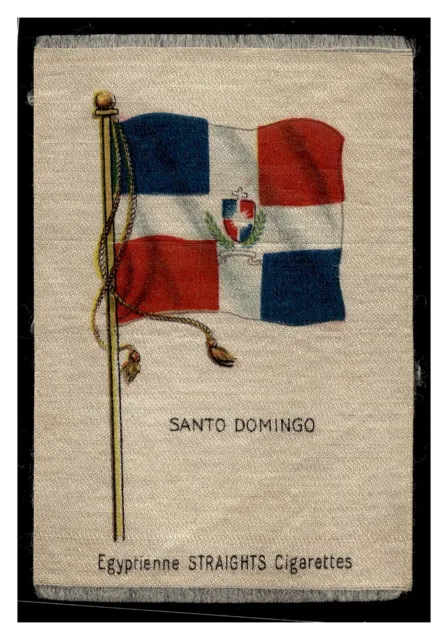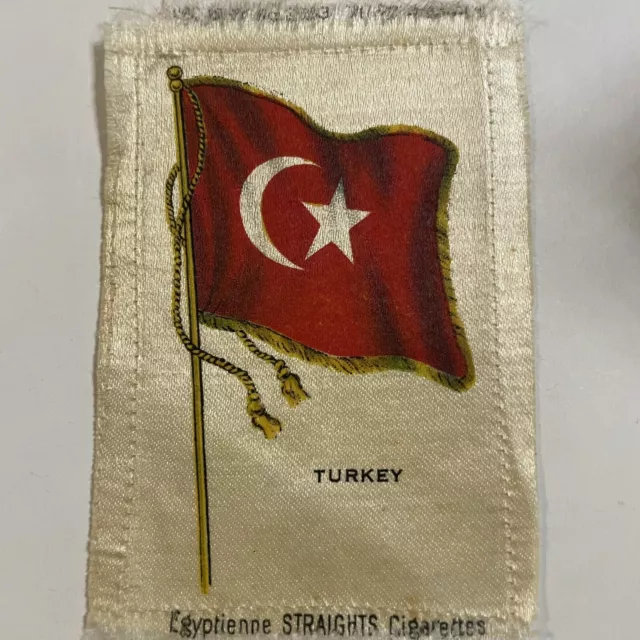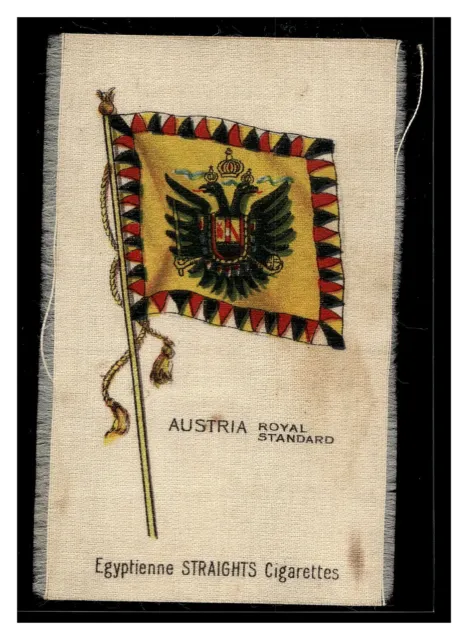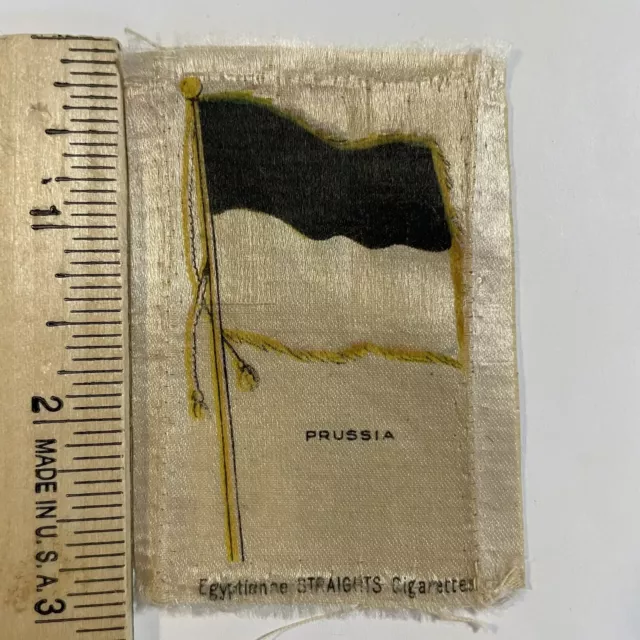Prussia Civil Flag Silk 1701-1935 Egyptian Straights Tobacco Cigarettes c. 1910
PRUSSIA civil flag 1701-1935 egyptienne straights cigarettes Tobacco Silk Circa 1910 / 1911 Used
Prussia was a German state on the southeast coast of the Baltic Sea. It formed the German Empire under Prussian rule when it united the German states in 1871. It was de facto dissolved by an emergency decree transferring powers of the Prussian government to German Chancellor Franz von Papen in 1932 and de jure by an Allied decree in 1947. For centuries, the House of Hohenzollern ruled Prussia, expanding its size with the Prussian Army. Prussia, with its capital at Königsberg and then, when it became the Kingdom of Prussia in 1701, Berlin, decisively shaped the history of Germany.
In 1871, Prussian Minister-President Otto von Bismarck united most German principalities into the German Empire under his leadership, although this was considered to be a "Lesser Germany" because Austria and Switzerland were not included. In November 1918, the monarchies were abolished and the nobility lost its political power during the German Revolution of 1918–19. The Kingdom of Prussia was thus abolished in favour of a republic—the Free State of Prussia, a state of Germany from 1918 until 1933. From 1932, Prussia lost its independence as a result of the Prussian coup and the Nazi Gleichschaltung laws, which established a unitary state. Its legal status finally ended in 1947.
The name Prussia derives from the Old Prussians; in the 13th century, the Teutonic Knights—an organized Catholic medieval military order of German crusaders—conquered the lands inhabited by them. In 1308, the Teutonic Knights conquered the region of Pomerelia with Danzig (modern-day Gdańsk). Their monastic state was mostly Germanised through immigration from central and western Germany, and, in the south, it was Polonised by settlers from Masovia. The imposed Second Peace of Thorn (1466) split Prussia into the western Royal Prussia, becoming a province of Poland, and the eastern part, from 1525 called the Duchy of Prussia, a feudal fief of the Crown of Poland up to 1657. The union of Brandenburg and the Duchy of Prussia in 1618 led to the proclamation of the Kingdom of Prussia in 1701.
Prussia entered the ranks of the great powers shortly after becoming a kingdom.[4][5] It became increasingly large and powerful in the 18th and 19th centuries. It had a major voice in European affairs under the reign of Frederick the Great (1740–1786). At the Congress of Vienna (1814–15), which redrew the map of Europe following Napoleon's defeat, Prussia acquired rich new territories, including the coal-rich Ruhr. The country then grew rapidly in influence economically and politically, and became the core of the North German Confederation in 1867, and then of the German Empire in 1871. The Kingdom of Prussia was now so large and so dominant in the new Germany that Junkers and other Prussian élites identified more and more as Germans and less as Prussians.
The Kingdom ended in 1918 along with other German monarchies that were terminated by the German Revolution. In the Weimar Republic, the Free State of Prussia lost nearly all of its legal and political importance following the 1932 coup led by Franz von Papen. Subsequently, it was effectively dismantled into Nazi German Gaue in 1935. Nevertheless, some Prussian ministries were kept and Hermann Göring remained in his role as Minister President of Prussia until the end of World War II. Former eastern territories of Germany that made up a significant part of Prussia lost the majority of their German population after 1945 as the Polish People's Republic and the Soviet Union both absorbed these territories and had most of its German inhabitants expelled by 1950. Prussia, deemed a bearer of militarism and reaction by the Allies, was officially abolished by an Allied declaration in 1947. The international status of the former eastern territories of the Kingdom of Prussia was disputed until the Treaty on the Final Settlement with Respect to Germany in 1990, but its return to Germany remains a topic among far right politicians, the Federation of Expellees and various political revisionists.
The term Prussian has often been used, especially outside Germany, to emphasise professionalism, aggressiveness, militarism and conservatism of the Junker class of landed aristocrats in the East who dominated first Prussia and then the German Empire.
In the Victorian era new embellishments were available, small "tobacco silks" or "cigarette silks," printed in a wide variety of motifs, and offered as premiums in cigarette packs. Women wouldn?t be smoking cigarettes ? God forbid! - but they would encourage the menfolk to smoke a certain brand so they could get the latest actress or bathing beauty silk.
The item that started the entire fabric fad, wasn't intended as a marketing tool. Cigar manufacturers used brightly colored silk ribbons imprinted with their brand names to tie bundles of cigars.
The colorful ribbons which came in yellow, orange, black, blue, green, pink, purple, red and white appealed to collectors and to women, who fashioned the ribbons into table coverings, quilts and pillows.
Cigarette companies wanted to distinguish themselves and develop brand loyalty much as they have in recent decades.
Zira Cigarettes, for example, developed a "prize-in-every package" advertising campaign designed to differentiate itself from other cigarette
brands and encourage brand loyalty. While many of the fabric swatches were given away, larger premiums were obtained by mailing in coupons. Some featured a series of items such as baseball players or flags, to promote collecting. One of the most popular promotional campaigns that the companies devised involved free fabric swatches depicting images of sports figures, actresses and more.
The tobacco companies encouraged women to make things using the fabric, and women obliged with quilts, pillow tops and table covers. The companies believed giving these items away would encourage smokers to chose one brand over another."
The advertising gimmick worked. In parlors of homes everywhere, men smoked while their wives fashioned the colorful fabric swatches into quilts, comforters, table scarves and clothes, this shows a marketing technique that is still used today.
For example, an inventive seamstress fashioned a Turkish dancer's costume in the 1920s from cigarette silkies. The colorful skirt and vest ensemble is a one-of-a-kind example of the domestic craftswoman's creativity.
A Michigan woman, Lena Searing Bergman, created a lounging robe using more than 700 printed velveteen and jacquard-woven miniature "rugs" with silk fringe obtained as tobacco company premiums. She hand-stitched each one onto a flannel base and lined the garment in red silk.
Other women used the designs of presidents, flags, and collegiate and professional athletes to create pincushions, table scarves, parlor throws, bed comforters and quilts
CLIX Cigarettes silk. The top of the silk reads “Factory No. 25, 2nd Dist NY .
Cigarette companies used silks as a promotional item.
- Condition: Ungraded
- Graded: No
- Franchise: History
- Set: Tobacco Silk Insert
- Character: Tobacco Silk Insert
- Manufacturer: Various see listing & images
- Features: Insert
- Convention/Event: Tobacco Silk Insert
- Card Size: Tobacco
- Autographed: No
- Signed By: Tobacco Silk Insert
- Autograph Format: Tobacco Silk Insert
- Year Manufactured: 1910
- TV Show: Tobacco Silk Insert
- Vintage: Yes
- Card Thickness: 20 Pt.
- Parallel/Variety: No Parallel
- Language: English
- Card Name: See images and title
- Featured Person/Artist: No Featured Person
- Movie: Tobacco Silk Insert
- Print Run: Limited
- Material: Tobacco Silk
- Age Level: 16+
- Insert Set: Tobacco Silk Insert
- Original/Licensed Reprint: Original
- Type: Non-Sport Trading Card
- Illustrator: Tobacco Silk Insert
- Card Number: see images & details
- Genre: History
- Country/Region of Manufacture: United States
PicClick Insights - Prussia Civil Flag Silk 1701-1935 Egyptian Straights Tobacco Cigarettes c. 1910 PicClick Exclusive
- Popularity - 0 watchers, 0.0 new watchers per day, 81 days for sale on eBay. 0 sold, 1 available.
- Best Price -
- Seller - 7,241+ items sold. 0.2% negative feedback. Great seller with very good positive feedback and over 50 ratings.
People Also Loved PicClick Exclusive

Santo Domingo 1910 American Tobacco Egyptienne Straights National Flag Silks
$22.14 Buy It Now 13d 6h
British Red Ensign Red Duster Union Jack Civil Flag Tobacco Silk Cigarettes 1910
$20.97 Buy It Now 10d 16h
Ottoman Turkey Red Crescent Star Flag Tobacco Silk Egyptian Straights Cigarettes
$15.13 Buy It Now 10d 16h
Egypt Crescent Moon Stars Flag 1882-1922 Tobacco Silk Nebo Cigarettes Circa 1910
$20.97 Buy It Now 9d 17h
Austria Royal Standard 1910 American Tobacco Egyptienne Straights Nat Flag Silks
$25.55 Buy It Now 13d 6h


